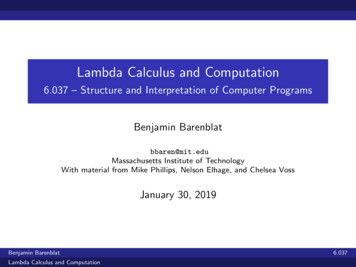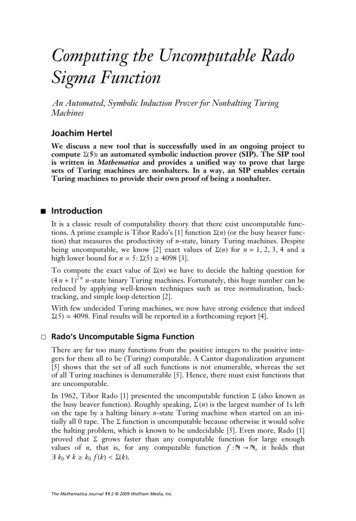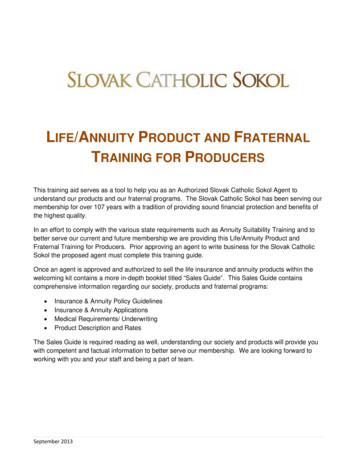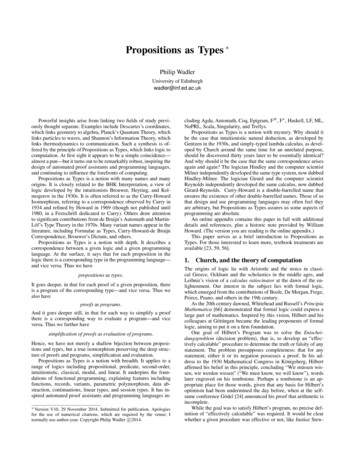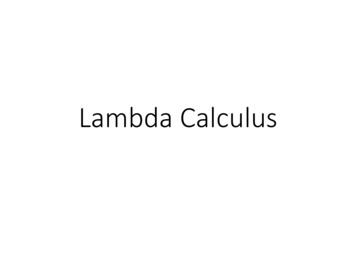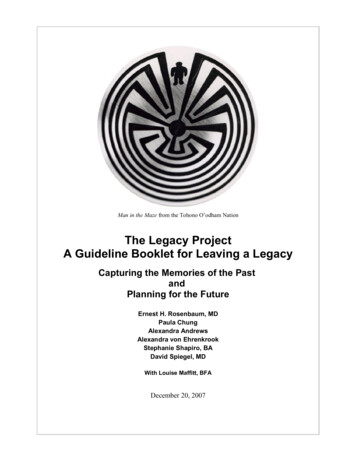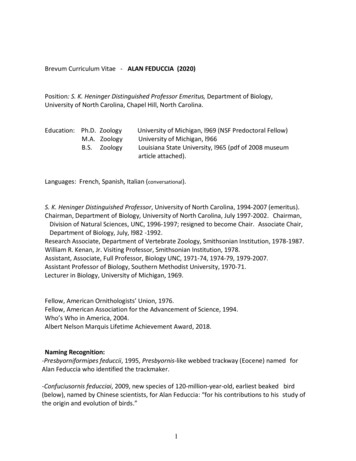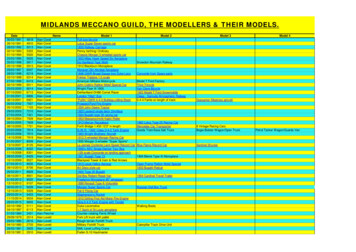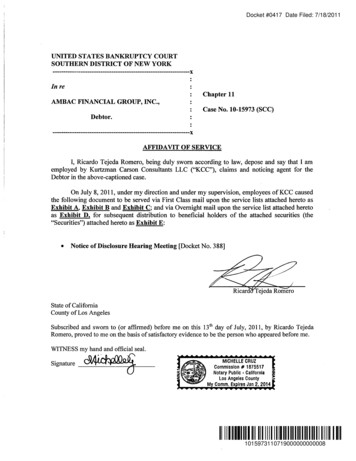
Transcription
Alan Turing: Life and Legacy of a Great Thinker
Springer-Verlag Berlin Heidelberg GmbH
Christof Teuscher(Ed.)Alan Turing:Life and Legacyof a Great ThinkerForeword by Douglas HofstadterWith 77 Figures, including 10 in Color, and 4 TablesSpringer
Christof TeuscherSwiss Federal Institute of Technology Lausanne (EPFL)Logic Systems Laboratory, er.cnhttp://www.teuscher.ch/christofLibrary of Congress Cataloging-in-Publication Data applied forDie Deutsche Bibliothek - CIP-EinheitsaufnahmeBibliographic information published by Die Deutsche BibliothekDie Deutsche Bibliothek lists this publication in the DeutscheNationalbibliografie; detailed bibliographic data is available in theInternet at htt p://dnb.ddb.de .ACM Subject Classification (1998): A.O, F, E.3, 1.2This work is subject to copyright . All rights are reserved, whether the whole or part of the material isconcerned, specifically the rights of translation, reprinting, reuse of illustrations, recitation,broadcasting, reproduction on microfilm or in any other way, and storage in data banks. Duplicationof this publication or parts thereof is permitted only under the provisions of the German CopyrightLawofSeptember 9,1965, in its current version , and permission for use must always be obtained fromSpringer- Verlag. Violations are liable for prosecution under the German Copyright Law.springeronline.comISBN 978-3-642-05744-1ISBN 978-3-662-05642-4 (eBook)DOI 10.1007/978-3-662-05642-4 Springer- Verlag Berlin Heidelberg 2004Originally publishedby Springer-VerlagBerlinHeidelbergNew Yorkin 2004.Softcoverreprintofthe hardcover 1stedition 2004The use of designations, trademarks, etc. in this publication does not imply,even in the absence of a specific statement, that such names are exempt fromthe relevant protective laws and regulations and therefore free for general use.Cover Design: Kunkell.opka, HeidelbergTypesetting : Computer to film by author s dataPrinted on acid-free paper45/3142PS 5432 I
Alan Mathison Turing (1912-1954)By courtesy of the National Portrait Ga llery, London
T he Universal Turing Machine Jin W icked , 2002, j inwi cked . com
ForewordIn 1950 , Alan Turing expressed the following provo cative sentiment : "We mayhope that machines will eventually compet e with men in all purely intellectualfields." While his choice of the noun "men" may dism ay us , at t he beginningof the 2pt century we know of cour se t hat for Turing, as for everyone backin t hose days , women were considered memb ers (at least in a cert ain limitedsense) of the class called "men," and so, though th e word may make oureyebrows (if not our hackles) rise a little, we should not make t oo big a fussover it .What might give us more pause for thought, however, afte r t his firstst umble, is the act ual hope that Turing expressed: that machines would comet o be our rivals in all "pur ely inte llect ua l" fields. P resumabl y this includes allt he scienc es, all the arts, all ga mes, all of humor, all of philosophy, and much,mu ch more. If ther e is any doubt on t ha t score, one need merely read the twoshort di alo gue snippets t hat he included in the same article, where one seesthat a subject (human or machine, one never knows) under interrog ation inthe Tu ring Test is qui zzed on such t opics as poetry, chess, and mathem atics,a nd passes with flying colors .*Did Alan Turing really delight in t he t hought that machines such as hehimself had designed would on e day write complex and powerful plays , compose heart-rending pieces of mu sic, invent uproarious jokes, discover fund amental new laws of nature, invent new branches of ma them ati cs, profoundlygr apple with eternal riddles about beauty, morality, and mortality - andso forth a nd so on ? Did Alan Turing actually suppose that machines mightcom e to be our intellectual rivals bu t would st op improving precisely at thatdelic ate point? Did he suppose that they might just bar ely come up to ourlevel but never surpass it ? Was Alan Tu ring susceptible t o t he same simplisticillu sion as so many gr eat chess players were, before Deep Blu e kno cked GaryKasparov for a loop? Did Alan Turing really think that the intelligence levelof human geniuses was esse nt ially a dream-like asy mpt ot ic goal for machinesrather than an arbitrary, uninteresting number that would turn out to betrivially surpass able as machines swooped up from zero, picking up the paceall t he whil e as they grew ever cleverer?
XForewordDid Alan Turing truly hope, or t ru ly believe, t hat his own level of intelligence - a level that most of us conside r wondrously insightful - would soonbe merely a qu aint relic , something that machines would look back on withamuseme nt as they recalled "t he old days" when human b eing s were oncet heir intellectual superiors? Did Alan Turing believe that one day machineint elligence would be t o human intelligen ce as human int elligen ce is to do gint elligence or even ant intelligence? Did Alan Turing in fact yearn for t hatday to arrive?I pose this series of lead ing questions but, of course, despite wh at he wro te,I don 't have the foggiest idea what Ala n Turing really hoped. I have to wonderif he carefully considered this idea of our bein g com pletely eclipsed in r athershort order. After all, his belief was that by the en d of t he 20 t h cent ury,machin es would fool intelligent interrog ators roughl y half t he time in theTuring Test - so where did he think that t rend would be pointing? Did hereally t hink it was something not t o wor ry about at all?** **There are those today who forecas t that computer intelligen ce will easilyoutflank human intelligence within just a few decades, leaving "us" behind inthe dus t . Or have I got it righ t ? Will "we" b e up ther e wi th them ? Or rat her,will we be up there in them? In short , will we be none other than they? Inoth er words, will t he English-language pronoun "we" have shift ed meaning,so t hat it refer s to the most advanced of all English speakers - namely, thosewho inherited the English lan guage from "us" a nd thereby earned t he rightto us-urp t he term from "us"? Would Alan Turing say that nothing essen ti alwould be lost in the passage from carbon-based minds and souls t o siliconbased minds a nd souls (or t o whatever medium won the evolutionary race tobecome the substrate for the highe st level of intelligence) ?I find it perplexing that someone so insightful would express t he hopeto be sur passed by alien entit ies. On t he other hand , I find it wonderfullyflexible and op en-m ind ed of Alan Tu ring to express such a st range desir e.What kind of a human being would utter such a hope? It would have tobe someone fascina ted by the question of wh at a mind is, someone fascin atedby t he fact t hat minds ar e natural con sequen ces of ver y simple physical processes t aking place in highly complex physical st ruct ur es. Alan Turing wasindeed fascinated by t he consequ ences of very sim ple proce sses t aking place incomplex st ru ctures; after all, the machines that he defined in order t o spe cifythe nature of comput ing - what we now call "Turing machines" - are asbarebones in their processes as one could im agine . Alan Tur ing sa w, though,t hat since the properties of t he na tural numbers could be st ud ied by writingl 's and O's on a long t ap e, there was in principle no lim it to the complexityof st ructures t hat could be create d in his machines. And t his in t urn led him
ForewordXIto the idea of a "univer sal" m achine - one that , given a des cription of anyother machine plus that m achi ne 's input , could emulat e t he other machineacting on that input.From emulation to empa thy - for adult hum an minds are, in a cert ainsense, universal Turing machines, and the other Turing machines that wespend most of our lives emula t ing are also uni versal Turing machine s (whichin turn are emulating yet other universal Tur ing ma chines , and on and on. . . ). Our souls a re built up in this highl y recursive ac t of having empathyfor b eings who a re empathe t ic to other being s who feel for yet others, andso on - with t he whole t hing twisting back on itself wit h a vengean ce, avengeance commonly known by t he rather short word spe lled "I". This vastnetwork of int erpenetrating empat hies is st rikingly like t he Buddhist imageof Indra 's Net - a galaxy of glass beads floating throughout space, each ofwh ich reflects all the other s, incl uding the others' reflections of yet others,a nd so on , a d indranetum .**** * ****I recall one time st anding right underneath two very tall television tow ersand marveling at their height and at t he fact that they were using Maxwell'sequations to send ou t incredibly intricate visua l and linguistic messages tot housands of distant sent ient beings - when all of a sudden I was broughtup shor t by t he reali zat ion t hat nearl y every t hing being beamed out from th ever y high tips of those marvelously thin met al towers was just soap op erasa nd advertiseme nts.This disappointed me enormously at first , since I was think ing loftythoughts, and I was imagining that simil arly lofty thought s were beingb eamed out t o the audiences. But after reflecting on this further , I realizedt hat soap oper as , though they may seem trivial an d st upid to me , ar e in factdeepl y comp lex ex pressions of what it is to be human - and , in fact , soare advert iseme nts. Indeed , adve rtisements are closely related to the battlesfor dominance tha t constit ut e t he essence of evolution, t hanks to which ourbrains, minds , a nd souls exist. And soap operas are all about our sets ofideas and how we reflect other people inside ourselves, and how they reflectus, and how we reflect their reflections, and vice vers a , and so on , foreve r.Thus, in the end, soa p operas, though th ey ar e no t philosophy or physics,are ver y deep representat ions of what it is t o be alive and to have a mind. Andthis hu ge entanglement with other human being s imp rints on each one of usa unique identity, a unique personal signat ure . Alan Turing, like every ot hersent ient m achi ne belonging t o the species Homo soapiens soapiens , was deeplythough imperfectly mirrored in hundreds of other such machines; moreove r ,
XIIForewordinside t he physical st ructures of his brain - in the met aphori cal 1's and O'sprinted on his met aphori cal Tu rin g-m achine tape - he mirrored hundreds ofsuch machines, also imp erfectl y tho ugh deepl y.And out of these imperfect, par ti al mirrorings ca me powerful yearn ings- yea rn ings to talk, to joke, to play, t o sh are, to touch . Ou t of t hose mult iple yea rn ings came dan gerou s liaisons, for Alan Tur ing was a bno rmal wit hrespect to the norms of his society. The ty pes of uni ver sal machines t hat hemost enjoye d mirrorin g, and t he uni versal machin es in which he most deeplyyea rne d t o be mirrored , were machines of his own genus - t he M genus asopposed to the F genus. Norm al , standard M machines yearned most highlyto mir ror F machines, and norm al , st andard F machines yearned most highlyto mirror M machines - bu t there were some mutated machines t hat wentfor ot hers of their own genus, and t his typ e of yearn ing, as perceived by thesociety of machines, was considered improper and deserving of punishment.Alan Turing t hus cam e to suffer for his dangerous liaisons that deviated fromthe norm .****What does a uni versal Turing machine do whe n it comes to realize t hatall Turing machines, no matter how p owerful, mu st soo ner or lat er grind t o afinal halt , even if t heir software would have t hem go int o a n infinit e rep eti ti veloop or even emba rk on an infinit ely long never-l ooping process? Does such amachine close its eyes to that fact a nd relish it s comp utations for as lon g asit s physica l circuits will allow? Or does such a machine waste billi ons uponbillions of cycles bemoaning it s unjust fa t e? Or do es such a machin e immerseitself in soap oper as a nd advertiseme nts in order to dist ract itself fro m it sinexorable final destiny? Or does such a machine per chan ce dream of puttingan end to it s own computations, and wonder if or whe n it might do so?Snow White partook of a poisoned apple, and Alan Turing followed suit;his computations, brilliant though t hey were , soon ground to a total , finalhalt . He was a hum an being whose complexity and whose insight sur passedtho se of nearly all other human beings, and yet he too succ umbed to the sametyp es of problems as befall the most ordinary saps in t he mos t banal of soapoperas . Indeed , what is beam ed from t hose t all t elevision a ntennas is evenmore complex, in its own way, t ha n J ames Clerk Maxwell 's unifi ed equat ionsof elect romagnetism, or Alan Mathison Tu rin g's resolution of t he riddle oft he halting problem , or Andrew Wil es ' proof of Fermat 's last theor em , orLudwi g vail Beethoven 's final few st ring qu artet s.
ForewordXIIIFu lly t o fathom even on e ot he r hum an being is far beyond our int ellectualca pacity - indeed , fully t o fathom even one's own self is an idea t hat quickl ylead s to absur dit ies a nd par ad oxes. This fact Alan Tu rin g und erstood moredeepl y t ha n near ly a nyone ever has, for it constit utes the crux of his work ont he halting probl em.*In t his volume ar e collected t he musings of a couple of dozen hum anbein gs who have been inspired by Alan Turing - who have each emulat ed,in some partial and imperfect fashion , the mind and soul of Alan Turing int heir own minds and souls. What would Alan Turing t hink of th ese modelswe have made of him in our head s? Would he throw back his head and laughhis famous raucous laugh? Would he be flattered ? Would he be impressed ordepressed by what some have mad e of his ideas? Would he even recogn ize hisown ideas in t he new guises in which t hey have been cast?It is sa d that we sh all never know anyt hing of the a nswers to these riddles,but we mu st not brood over it too long. Instead we should savor the musingst hat Alan Turing inspired in some of today's bri ghtest minds, for it is in thosemu sin gs , occasion ally a little bit muddied but oft en spa rklingly br ight , thathis spirit lives on , in a par ti al and imp erfect fashion.Au gust 2003Douglas HofstadterIndian a Univers ity
PrefaceIt was in Sep tember 2001 wh en I suddenly realized that Alan Mathison Turingwould have celeb rated the anniversary of his 90t h birthday on June 23, 2002 .Out of this sudden flash of thought originated - after a grea t deal of work ofcourse - t he Turing Day and ultimately the volume you hold in your hands.The Turing DayThe Turing Day ' (see a lso [1]) was int end ed to comm emorate t he anniversaryof Alan Mathison Turing's 90 t h bir thday, to revisit his seminal cont ribut ionst o com puter science , artificia l intelligence, biology, cry ptology, and manyother field s, but also to delinea te t he imp or t an ce of Tu rin g's fundamentalwork for contempo rary a nd futur e trends in science and society. The work shopconsiste d in a series of invit ed talks given by internati on ally renowned experts in t he field. A photo of the Turing Day speakers is rep roduced in Fi g. 1.Daniel Mange, director of t he Logic Syst ems Labor a tory at t he SwissFederal Inst it ut e of Technology in Lau sanne, and organizer of t he sui generisvon Neumann Day 2 in 1997 , delivered th e Turing Day 's inaugur al address ,whi ch shall be reprinted her e.Ladies and Gen t lem en , Dear Colleag ues , Dear Friends,On the 23 r d of June of this yea r, Alan Turing would have been 90years old. Nowadays, 90 is not an uncommon age. If Law in the 1950shad been differ ent, Alan Turing could hav e been amo ng us t oday.Respecting Turing' s cho ice, we org ani zed thi s confere nce withouthis physical presen ce. Bu t his spirit will inspire all of us during t hisvery special day.12Turing Day : Com p uting Sc ienc e 90 Years from the Birth of A lan Mat hison Turing,E P F L, La usanne , June 28 , 2002 , http ://www .teu scher. ch/tur i ngday.Von Neumann Day : Bi ological Inspiration in Com puter Sci ence 40 Years fromth e Death of Joh n von N eumann, E PFL, Lausanne, July 25, 1997,ht tp ://l slwww. epf l .ch/pages/eve nt s/neumann97 .
XVIPrefaceFig. 1. The Turing Day spe akers (from left to right) : Martin Davis, Gi anluca Tempesti, C hristof Teuscher , Jon athan Swin t on , B . J ack Co peland , Tony Sale, DanielMan ge, a nd Andrew Hod ges. Douglas Hofst adter was , unfortuna t ely, a bse nt fromt his ea rly -mo rn ing roll-call. And rew Hod ges wears a Turing '90 T -shir t left overfrom t he Turing 1990 conference at Sussex Univers ity (@ Alain Herzog, EPFL)Those of you who attended our von Neumann Day, five years ago,have already observed the stran ge similarit ies between Turing' s andvon Neumann's scientifi c car eers despite their complet ely differentsocial behaviors: while Alan Turing was a romantic and lonesomet alent, John von Neumann enjoyed worldly pleasures. Turing's andvon Neumann's maj or cont ributions may be divided into three periodsof t heir lives: the pr ewar , war , a nd postwar peri od s, or using a notherpersp ecti ve, t he mathematical , t he computat ional, and t he biologicalperiod s.In 1936 , Alan Turing conceived t he fundam ent al t heor ies of compu t er science while pr oposing his abstract machine, t he Turing machine. During the sa me period, John von Neumann addressed mathemat ica l theories such as game theory, the logic foundation of mathemat ics, and quantum mechanics.During World War II , Turing played a major ro le at BletchleyPark, br eaking t he German Enigm a code as a membe r of a t op- secretBri tish operation. At t he sa me t ime, von Neumann began to cont ribute incr easin gly to t he war effort, covering t he t heory of detonation, ae rody namics, and at omic bo mbs. Both men were naturally ledt o face a huge number of calculations , so t hat t hey were both involvedin t he design and t he use of t he first progr ammable electro nic computer s: the Colossus, followed by t he Au tomatic Comput ing Engine,design ed by Alan Turing, the EDVAC (Electronic Discrete Variable
PrefaceXVIIArithmetic Computer) machine, followed by the computer design edby John von Neumann at the Institute for Advanced Studies.As a passionate botanist Alan Turing threw himself into the computer simulation of plant growth to bring an original contributionto the understanding of the morphology of living organisms. Johnvon Neumann proposed at the same time the first computational approach to the generation of lifelike behavior; and quite naturally, hisself-r eplicating automaton was built around a universal Turing machine.According to Bletchley Park's witnesses, Alan Turing was "Themos t brilliant mind of his time," or "The right man, at the right time,at the right place."Perhaps the most intriguing question about Turing is the one addressed at the end of our program by Andrew Hodges: "What wouldTuring have done after 1954?"In my mind , it 's cryst al clear: Turing would have been fascinatedby the mysterious DNA double helix, would have considered thegenome as a secr et message, and deciphered it by using his favoriteweapon, an artificial neural network.I'd like to warmly thank all our distinguished sp eakers; many ofthem didn't hesitate to come from the other side of the world!The organization of our Turing Day was mad e possible thanks toour gen erous sponsors. I'd like t o express my deepest gratitude to theCogito Foundation (Dr. Simon and Dr . Christof Aegerter), the MigrosCulture P erc entage (Mr. Dominik Landwehr) , Dr. Charles Maillefer,and Elsevier Science (Mrs. Betsy Lightfoot). The collaboration ofBolo's Computer Museum (Mr . Yves Bolognini and Edouard Forler),of Dr. Frode Weierud (for pr esenting the Enigma machine) , and ofEPFL staff (Service de presse et information, Service audiovisuel,At elier de reprographie) is warmly acknowledged.Last, but not least, it's my pleasure to point out the outstandingorganizer 's t alent of Christof Teusch er, t he creative entrepreneur ofthe Turing Day, and to thank him for his commitment.Thank you for your participation and have a great Turing Day!June 28, 2002Daniel MangeLogic Systems LaboratorySwiss Federal Institute of Technology, LausanneThe Turing Day brought together an int ernational and very heterogeneousaudience exceeding 250 participants, all with very different areas of interestand expertise - reaching from a dentist enthused by Turing since his child-
XVIII Prefacehood to an archaeologist fascinated by t he E nigm a machine. T he confere ncehas shown that an import ant number of t opics led or inspired by Tur ingcont inue to feed passionate scientific deb at es a nd t hat a numb er of questi onsremain un solved. As t he day concluded, ed it ing a fests chrift in memory ofAlan Tu rin g's 90t h bir thday seemed almost a corollary.About this B ookA lan Tur ing: Life and Legacy of a Great Thinker contains a comprehe nsivecollect ion of essays with t he goa l t o shed light on Alan Tur ing, his t houghts,his life, and his rich legacy. I am of cour se very lucky t hat all Turing Dayspeakers cont ribut ed to t his volume an d t hat many other ex pe rt s could beconvinced to submit a cha pt er as well. All contributions have been writ tenfor t he general scient ific reader , should be fairly self-contained , a nd hence b eread ab le by non-specialists as well.T his book is divided int o several parts t hat shall be bri efly describ ed int he following .Part 1 is dedicated to Turing's life, t hought, a nd p ersonality in gen er al,and starts wit h an int ro duct ory biography, specially contributed by Tur ing 'sbiograp her Andrew Hodges for t his volume.T he second cha pter is a fairly unconvent ional contri bution for a rathertechnica l book. Valeria Patera's play "Alan's Apple," present s as an en igma,t he life, deat h and destiny of Alan Tur ing .Andrew I-Iodges asks in his second contr ibution "W ha t would Alan Turinghave done afte r 1954?," an obviously only hypothet ically answe rable qu estion.Hod ges surveys Turing's late interest s and incomplet e t hreads , and also dispu tes t he controversial claim s t hat Turing ant icipated t he agenda of so-called"hypercomput ing," a topic t hat shall be furt her discussed in P ar t 2 of t hisvolume .Dan iela Cerq ui shows that t he two main t end enci es in today 's "information society," an increasing valor ization of mind , information, an d moregenerally immaterial element s, as op posed to body a nd mat t er , and a st ro ngt end ency to replace every t hing human with artificial eleme nts, wer e alreadypr esent in Tur ing's t hou ght as early as t he 1940s. Her contribut ion sheds lighton t he links between t he man , t he mathematician , an d our pr esent soc iety.P art 2 begins wit h a survey by Michael Beeson on t he mechani zation ofmathematics, which refers to t he use of comput ers to find , or to help find ,mathem at ical pro ofs. While Turing has shown that a complete reduction ofmathematics to comput ation is impossible, t he next t hree chapters of P art 2focus on a fairly controversial field of research on algor it hms a nd machinesclaimed to compute beyond t he com put a t ional lim it of Turing machines. In
PrefaceXIXhis survey on hyp ercom put a t ion , Mike St annet t describes various approachesto construct ing hypercomput a t ional machines, while Eugene Eberbach, DinaGold in , and P et er Wegner present new super-Turing mod els of computation- a ll basica lly inspired by Turing's ideas - which t hey cla im are more appropriate for today's int era ct ive, networked a nd embedded computing systems .The practi cality of physica l hyp ercomput ati on has , in fact , been quest ioned by several researchers. Mos t hyp ercomput er models involve analogcomputat ion with infinit e precision or try to compute t he "infinite" in finit et ime . T he las t chapte r on t his much debated field comes from Mart in Davis,who provides a first cr it ica l essay and concludes that none of t he hypercomput a ti onal models attains non-comput ab le outputs unless t he inpu ts are alsopermitted to be non-comput a ble.Many a hyp ercomput at ionalist placed or st ill plac es a lot of hope in t hefield of quant um com puter s. Christ opher G. T impson arg ues in his chapt er against Deutsch 's clai m t hat a phys ical pr inciple, t he Turi ng principle,underli es t he famou s Chur ch-TUring hyp othesis.Hect or Fabio Rest repo, Gianluca Tempesti and Dani el Man ge br ing usback down to ea rth from t he t heo retical realms of hypercom put ers and describe a biologica lly inspi red hardware architecture endowed wit h universalcomputat ional capabilit ies. T he novel mu lt icellular archit ecture is robust anda ble to self-re pair and to self-r ep licate.In t he las t chapter of P a rt 2, Andrew J . Wells considers the impact of t heTuring machine on t he development of t heories in cognit ive science . TUring'swor k shows - as Andrew argues - t hat it is highly pr ofit able to st udy themi nd fro m an ecological p erspective, i.e., to st udy t he organisms in relat ionto t heir environme nts.Part 3 is ab out a rtificial int elligence and t he famo us Turing test . T heope ning shot is p rovided by philosop her Daniel C. Denn et t 's semina l essay"Ca n Machines T hink?" His main goal was to show how huge t he t ask posedby t he Turing Test is, a nd hen ce how unlikely it is t ha t any compute r willever pass it. Den net t 's philosop hical conclusion is t hat we could safely ascribet he term "int elligence" to a ny compute r t hat actually passed t he Turi ng t est .In t heir chapt er, B. J a ck Cope land and Dian e Proudfoot first discuss TUring's ro le in t he histor y of the compute r and in t he ea rly stage of artificialint elligence. They fur ther provide interesting arguments on why various object ions to the Turing t est fail.Helmut Schnelle's chapt er ent itle d "Not e on Enjoying Strawb erries wit hCream, Ma king Mist akes , a nd Ot her Idioti c Fea tures," is a n invent ive contribution on algorit hms, com putation, and hu man a nd machine int elligencewit h referen ce to t ho ug hts of von Neumann and Weyl, Carnap and Bar-Hillel,and, finally, G6d el and Wang.Diane P ro udfo ot illu mina t es in her essay on "Robots and Ru le-Following"t he ove rlap and differences between Turing's and Wit t genst ein 's work in botht he philosophy of mathematics and t he philosop hy of artificial int elligence.
XXPrefaceShe shows, for example, that Wittgenstein's externalist analysis of psychological capacities entails that future "art ificially intelligent" computers androbots will not use language, possess concepts, or reason.This part is concluded by a contribution from the visionary Ray Kurzweil,winner of the 1999 National Medal of Technology, the highest honor in technology in the US. Ray guides us through the realms of exponent ia l technicalchange and argues that within a few decades machine intelligence will surpass human intelligence, leading to The Singularity, a technological change sorapid and profound it will represent a rupture in the fabric of human history.Ray's chapter delineates a possible - certainly fairly speculative - futureof machine intelligence, which has its origin in the work of Alan Turing.Part 4 disclos es some secrets of the famous Enigma ciphering machine,which played a crucial role in the Second World War and has meanwhilefound its way into many thrillers and films . This part depicts Alan Turing'swork and influ ence during the Second World War and illuminates his decisiverole in the process of breaking the Enigma code.Elisabeth Rakus-Andersson provides an essay on the Polish brains behindthe breaking of the Enigma code before and during the Second World War,whereas Tony Sale reports on Alan Turing's work at Bletchley Park during thewar . Sale's chapter further contains many technical details on the functioningof the Engima machines.Alan Turing's visit to the US Navy Cryptanalytic Section and the USArmy Signal Security Agency during the winter of 1942-1943 is presented indetail in Lee A. Gladwin's chapter. Turing's visit was a significant milestonein the collaboration between the Government Code and Cypher School atBletchley Park and its US counterparts to develop Army and Navy versions ofthe British Bombe and additional aids to defeat Enigma. Gladwin concludesthat "Alan Turing's visit to America that winter of 1942-1943 began withEnigma and end ed in myst ery."Part 5 contains Jonathan Swinton's chapter on Turing's last, almost lost,somehow obscure, and ill-understood work on Fibonacci phyllotaxis. Swintondiscusses the evid ence that Turing had developed a number of key ideasclose to modern thinking, and tantalizing hints that he came very close to amathematical explanation of how the daisy grows into its typical patterns.The last chapter is the editor's one on Turing's almost forgotten connectionist ideas. Most aspects of Turing's "unorganized machines" a re illustrated,including several extensions, as well as a toy application of the "genet ica lsearch" Turing proposed .
PrefaceXXIAcknowledgmentsEditing this book would certainly not have been possible without the enormous help of numerous people. I am very grateful to all friends who stronglyencouraged and morally supported me.The sweetest and most specia l thanks go to my most beloved wife, Ursina,who - as always - uncompromisingly and const ant ly supported me everyday and night!I am deeply indebted to all contributors to this volume for their commitment and their confidence in t he process of editing this volume.I am very grateful to all the friends and colleagues who read early portionsof the manuscript an d helped to greatly impro
X Foreword Did Alan Turing truly hope, or truly believe, that his own level of intelli gence - a levelthat most of us consider wondrously insightful - would soon
